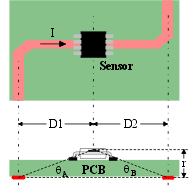 | In This Issue |  |

 | Quick Links |  |

 | In the News |  |
| NVE’s expansion was highlighed in a feature article in the August 13 Minneapolis/St. Paul Business Journal:
| “ |
We want to expand capacity before we need it.
| ” | | <More> |
| |
|

 | Fun Facts |  |
|
How's this for low power? IsoLoop Isolators use only one-third
of a nanojoule of switching energy, so they can switch over 100 million times using less than the nutritional
energy in one cracker crumb (0.00001 Calories).
Speaking of crumbs, two bits are known as a “crumb,” and nearly 40 two-channel IsoLoop Isolator configurations are available
in packages as small as MSOPs.
<More Fun Facts> | |
|

 | Voicemail Playlist |  |
|
In honor of Labor Day, “I’ve Been Working on the Railroad” is our telephone system background music.
And because of their ruggedness, reliability, and long life NVE sensors and isolators are popular in transportation systems. | |
|

 | Labor Day |  |
|
NVE will be closed Monday, September 6 for Labor Day. | |
|
 | |
| Labor-Saving Kits |
|
 Sensor evaluation kits save labor by providing what you need to prototype a GMR sensor system. Kits include sensors, magnets, and test circuit boards, so you don't have to waste time researching sensors, finding magnets, or designing boards. Sensor evaluation kits save labor by providing what you need to prototype a GMR sensor system. Kits include sensors, magnets, and test circuit boards, so you don't have to waste time researching sensors, finding magnets, or designing boards.
Several kits are available:
We have a labor-saving online store where you can order labor-saving sensor evaluation kits today for delivery tomorrow. Just click here:

|
| Labor Day Application Corner |
|
Labor Saving Tools for Calculating Current-Induced Magnetic Fields
By Jay “Kit” Brown
Vice President, Sensors
One of our most popular applications is detecting overcurrent without a direct connection using a AA-
or AAH-Series GMR magnetometers over or near a circuit-board trace.
If you're like most people, you'd rather not dig up the Biot-Savart law and Maxwell's differential equations to figure out the magnetic field produced by the ac or dc current in a circuit board trace.
That's why we have a FREE labor-saving Excel spreadsheet to do those calculations for the following configuration:

The axis of magnetic sensitivity is along the package with the current-carrying
trace on the opposite side of circuit board from the
sensor:
The spreadsheet calculates the magnetic field at the sensor element based on the current in conductor and the geometry of the circuit board.
Suppose, for example, we want to detect 10 A overcurrent. With a SOIC-packaged sensor on a 1.6 mm thick PCB with 3 oz plated copper, r = 2.94 mm. If D1 = D2 = 10 mm, the spreadsheet shows the critical field strength at the sensor is 6.54 oersted. A circuit can easily be designed with an AA002-2 sensor and a comparator to switch at 6.54 oersted or 10 A.
The field depends sensitivity variations, board thickness, and soldering precision, but accuracy is generally sufficient for
overcurrent protection.
For more information on current measurement designs, including a detailed circuit for this example, see Application Bulletin No. SA-1 (.pdf).
<Download the Current Field Calculator (.xls)>
<Buy the AG003-01 Current Sensor Evaluation Kit> |
| |

